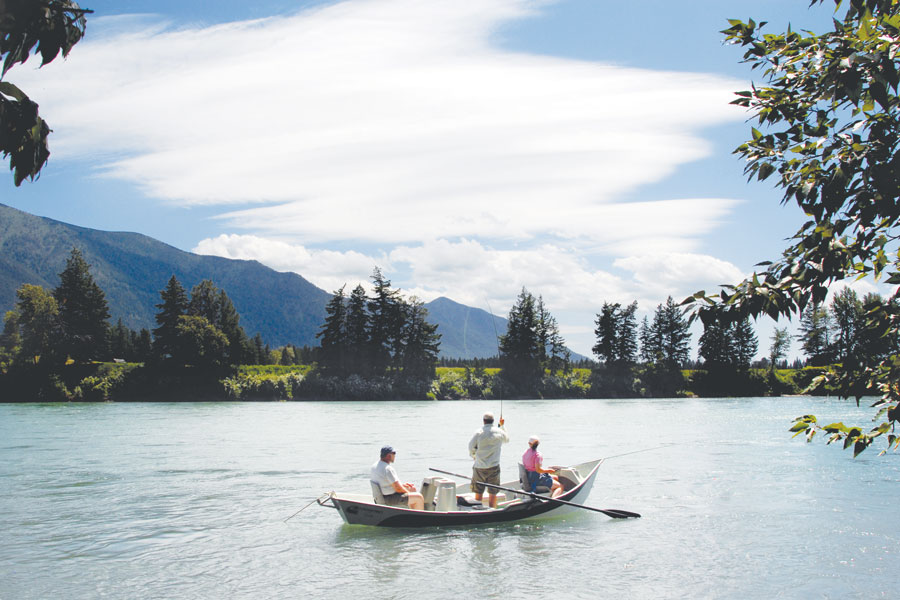In passing the largest conservation legislation in a decade, an oft-divided U.S. Senate this month furnished a public lands package with bipartisan support, and in doing so lawmakers sent a message to their constituents that protecting millions of acres of land and hundreds of miles of wild rivers isn’t just good for the environment — it’s also good for the economy.
Montana’s entire congressional delegation celebrated significant home-state gains in a sprawling package that combined more than 100 bills into one, designating new river miles as wild and scenic, creating thousands of miles of new trails and setting aside nearly 700,000 acres of land for new recreation and conservation.
Parsing through the finer points of the 662-page measure, which passed 92-8, would be a complex assignment, but economic development and the business of outdoor recreation formed the bedrock of the near-unanimous vote, and helped forge a diverse coalition of advocates for public lands and conservation.
The win for conservation comes at a paradoxical time for conservation as President Donald Trump aggressively promotes development on public lands and energy independence, scaling back safeguards set by former administrations and drawing criticism from environmental advocates.
But money talks, and one thing everyone can agree on is that carefully curated conservation measures foster economic growth and development.
“It touches every state, features the input of a wide coalition of our colleagues, and has earned the support of a broad, diverse coalition of many advocates for public lands, economic development and conservation,” Senate Majority Leader Mitch McConnell, R-Kentucky, told reporters after the vote.
Included in the omnibus public lands bill, which passed on Feb. 12, was a measure to reauthorize the Land and Water Conservation Fund in perpetuity, and another to block a proposed gold mine on the outskirts of Yellowstone National Park.
“The Land and Water Conservation Fund is a driver of Montana’s $7 billion outdoor economy,” U.S. Sen. Jon Tester, D-Montana, a longtime proponent of the fund, said. “Hunters, hikers, and anglers will now have the long-term certainty they need to increase public access to our public lands and preserve these outdoor spaces for generations to come.”
Between 2005 and 2014, Montana received $240.3 million in investments from LWCF funds, which contributed to the purchase of more than 800 recreational sites across Montana, including city parks, trails and ball fields, tennis courts and municipal swimming pools.
Established by Congress in 1964 to conserve open spaces, fish and wildlife habitat and cultural, historic and recreation sites, the Land and Water Conservation Fund uses a portion of royalties from offshore oil development. The law allows funding of up to $900 million, but that has only happened twice in the fund’s 54-year history. Congress funded LWCF at $425 million this fiscal year, but the program expired Sept. 30.
The lands package included the Yellowstone Gateway Protection Act to permanently withdraw federal mineral rights on roughly 30,000 acres of the Gallatin National Forest and prevent proposed mines from expanding onto unclaimed public land adjacent to the park. Tester worked with a coalition of local residents and small-businesses owners to craft and introduce the bill after a pair of mining companies announced plans to expand their operations around the Paradise Valley back in 2015.
“Words cannot express the gratitude we feel toward Montana’s delegation right now,” said Colin Davis, owner of Chico Hot Springs. “We wouldn’t be anywhere without Sen. Tester’s unwavering leadership and his commitment since day one. Now, we just need one final push to permanently protect our jobs and way of life in the Paradise Valley.”
The package was also championed by Montana Republicans U.S. Sen. Steve Daines and U.S. Rep. Greg Gianforte.
“Today’s vote is a watershed moment for conservation and public lands across Montana and our entire country,” Daines stated following the vote. “From permanent reauthorization of LWCF to permanent protection of Paradise Valley, I’m very pleased we passed this important package today in the Senate. I urge the House to act quickly so that we can get it onto the President’s desk for his signature.”
According to the Outdoor Industry Association’s most recent figures, outdoor recreation is now the largest sector of Montana’s economy, generating more than $7 billion per year in consumer spending and supporting over 70,000 jobs that pay more than $2 billion worth of wages. Those figures don’t account for indirect economic effects, such as the numerous startups and small businesses that choose to locate here because of the state’s outdoor recreation opportunities.
Late last year, a poll of 822 owners and managers of outdoor businesses in Montana, Colorado, Nevada and New Mexico found that eight in 10 businesses support reauthorizing the LWCF.
Key findings of the poll include: 82 percent of those surveyed believe Congress should reauthorize the fund, including 79 percent of Montanans surveyed; nearly eight in 10 business owners believe LWCF helps their state’s economy; 73 percent of business owners believe public lands and the increased access provided by LWCF and similar programs help their business recruit and retain high-level employees.
Meanwhile, the Center for Western Priorities released a new report that identified and examined public land projects proposed by federal agencies from 2014 to 2017.
The analysis found that 20 projects funded LWCF were completed during this four-year-period in Montana, conserving at least 90,100 acres. The completed projects helped conserve swaths of land in Glacier National Park, the Lewis and Clark National Forest, Flathead National Forest, Charles M. Russell National Wildlife Refuge, and more, according to the report. Additionally, a project in the Lolo National Forest is in the process of being completed.
At least 16 LWCF projects in Montana covering 16,800 acres were proposed by federal agencies but are not yet completed.
